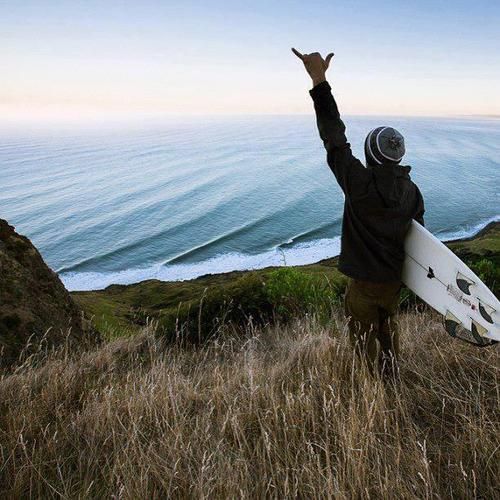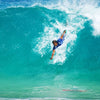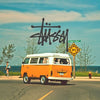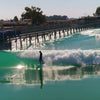What does shaka mean - The story behind the famous hand sign

What does shaka mean? The story behind the famous hand sign
The shaka is a hand gesture made by extending the thumb and pinky while curling the other three fingers. It means “aloha,” “hang loose,” or “take it easy,” and it symbolizes friendship, goodwill, and the laid-back spirit of Hawaii. In surf slang, “shaka brah” roughly translates to “right on, brother”, a friendly, positive greeting used among surfers worldwide.
Recognizable everywhere from the beaches of Oahu to social media captions, the shaka is much more than a casual gesture. It carries deep cultural roots in Hawaiian identity and has become an international sign of solidarity, kindness, and stoke.
What is the shaka sign?
A quick description of the gesture
The shaka is formed by holding up the thumb and pinky finger while tucking in the middle three fingers. Often accompanied by a subtle shake of the hand, it’s used to greet, thank, or acknowledge someone without saying a word.
In Hawaii, it’s an everyday expression of the “aloha spirit.” Whether you're letting someone merge in traffic or saying goodbye to a friend, the shaka keeps things friendly, respectful, and relaxed.
Common phrases: “Shaka brah” and their meaning
“Shaka brah” is a phrase popularized by Hawaiian surfers and locals. “Brah” is a Hawaiian Pidgin version of “bro” or “brother,” and when paired with the gesture, the phrase becomes a laid-back, affirmative greeting.
It can mean “cool,” “all good,” or simply be used in place of a nod or wave. While it started in Hawaii, the phrase is now heard across surf towns and beach cultures around the world. You’ll often hear it alongside other iconic surfer expressions many of which you can learn by diving into this guide to surfing term.
The origins of the shaka
Hawaiian legends and early stories
While the exact origin of the shaka isn't officially documented, most historians and locals point to Hawaii as its birthplace. One of the most accepted stories traces the gesture to Hamana Kalili, a Hawaiian plantation worker from Laie on Oahu’s North Shore in the early 1900s.
According to local accounts, Kalili lost his three middle fingers in a sugar mill accident. After the injury, he took a job as a railroad guard, waving at passing trains using his now-unique hand shape thumb and pinky extended. Children began copying the gesture as a playful signal, and soon it spread across the islands.
The Hamana Kalili story
Hamana Kalili wasn’t just a mill worker. He was also a respected community member, choir director, and active figure in local church and cultural events. Over time, his distinctive wave once just a safety signal became an informal symbol of greeting and goodwill.
Locals would spot him directing choirs with his shortened hand and greeting people at community events. His wave became so recognizable that children began using it as a kind of code or sign, mimicking his gesture while sneaking rides on the sugar trains.
Other possible origin stories
While Kalili's story is the most widely accepted, several alternative theories exist:
-
Some believe the gesture came from Spanish immigrants who greeted Hawaiians with a hand signal mimicking drinking (thumb to mouth, pinky up).
-
Others connect it to visiting whalers using a tail-like motion to signal a catch.
-
A theory from World War II ties the shaka to a variation of the “V for Victory” sign, where the hand was shaken instead of held still possibly leading to the name “shaka.”
David “Lippy” Espinda, a local TV personality and used car salesman, also played a role in spreading the gesture. In the 1960s, he ended his commercials with the phrase “Shaka, brah!” and flashed the hand sign, helping popularize both the gesture and the expression in mainstream Hawaiian culture.

The cultural meaning of the shaka
Aloha spirit and Hawaiian values
In Hawaii, the shaka is more than just a wave or casual gesture it’s a visual shorthand for the aloha spirit. This spirit represents kindness, compassion, humility, and a deep respect for others. When someone throws a shaka, they’re not just saying hello or goodbye; they’re extending warmth and connection.
Local pride and daily life in Hawaii
The gesture is used across generations, from kids to elders, and appears in both casual and formal settings. Politicians, schoolteachers, bus drivers, and surfers alike use the shaka to express everything from excitement to approval.
It’s also tied closely to Hawaiian identity. For many locals, the shaka reflects pride in their heritage and way of life one rooted in humility, openness, and cultural unity.
When and how locals use it
A key part of using the shaka is knowing when and how to do it. In Hawaii:
-
A shaka with the back of the hand facing out is a typical greeting or thank-you
-
A subtle shake adds enthusiasm or friendliness
-
It’s often used without words, especially in situations where gestures speak louder than speech
The shaka in surfing culture
How surfers adopted the gesture
The shaka became a natural fit in surfing communities thanks to its simplicity, visibility, and good vibes. As surfing expanded beyond Hawaii in the 1950s and 60s first to California, then Australia and the rest of the world surfers carried more than boards with them. They brought the culture, and with it, the shaka.
In the surf lineup, the gesture became a wordless way to say “nice wave,” “thanks,” or “go ahead.” It was a form of communication that matched the rhythm of the sport: low-key, respectful, and rooted in camaraderie.
“Shaka brah” and surf slang
The expression “shaka brah” quickly became part of surf slang. “Brah” is a Hawaiian Pidgin variation of “brother,” used in the same way as “dude” or “mate.” Put together, “shaka brah” means something like “right on, bro” or “it’s all good.”
Iconic surfers who helped spread it
Surfers like Duke Kahanamoku helped bring Hawaiian surf culture to the world, and the shaka was part of that cultural wave. As global competitions, surf films, and modern surf clothing brands rose to prominence, the gesture became permanently tied to the identity of the sport.
Global popularity and mainstream use
From Hawaii to Hollywood
What started as a local gesture has now become a global symbol, thanks in part to media, tourism, and the surf industry. As Hawaiian culture gained visibility through films, TV, and travel marketing, the shaka became a visual shorthand for island life and positive energy.
Sports, celebrities, and pop culture
Athletes in and beyond surfing regularly use the shaka to celebrate victories or connect with fans. Celebrities and musicians, particularly those with ties to Hawaii or surf culture, have also helped spread the gesture to global audiences.
Emojis, memes, and digital life
The 🤙 emoji, officially called the “call me hand,” is now widely used to represent the shaka online. On social platforms like Instagram and TikTok, the gesture symbolizes positivity, community, or just a chill mood — keeping its spirit alive in digital conversations.
Shaka etiquette: when (and when not) to use it
Respecting Hawaiian culture
While the shaka is used globally, it originated in Hawaii and carries deep cultural weight. It’s more than a photo prop — it represents aloha and mutual respect. Using it naturally and with awareness honors its meaning.
Common misuses by tourists
The gesture can feel inauthentic when overused or used mockingly. Tourists may flash it too often or without understanding its context. Like most cultural symbols, its power lies in being genuine and situational not in repetition.
Hawaii declares the shaka its official state gesture
The 2024 state law and what it represents
In 2024, Hawaii officially declared the shaka its state hand gesture. The legislation, inspired by a local filmmaker’s documentary on the gesture’s history, passed with unanimous support. It marked the first time a U.S. state had adopted a hand sign as an official symbol.
The move aimed to honor and protect a uniquely Hawaiian tradition one that is deeply tied to identity, tourism, and everyday life.
Local reactions and cultural pride
The law was celebrated across the islands. For many Hawaiians, it affirmed the shaka’s place not only in daily life but also in the state’s cultural and economic narrative. It’s a symbol that belongs to Hawaii — and now, legally, it always will.
The shaka as a universal symbol
Peace, positivity, and connection
Across cultures and languages, the shaka remains a quiet but powerful way to say “we’re good.” It doesn’t demand attention — it offers it. It doesn’t divide — it connects.
How the meaning can shift in different countries
While its origin is Hawaiian, the shaka has taken on local flavor wherever it’s gone. In some countries it means “cool,” in others it’s used humorously or casually. But the core message stays intact: nonverbal respect, friendliness, and shared humanity.






